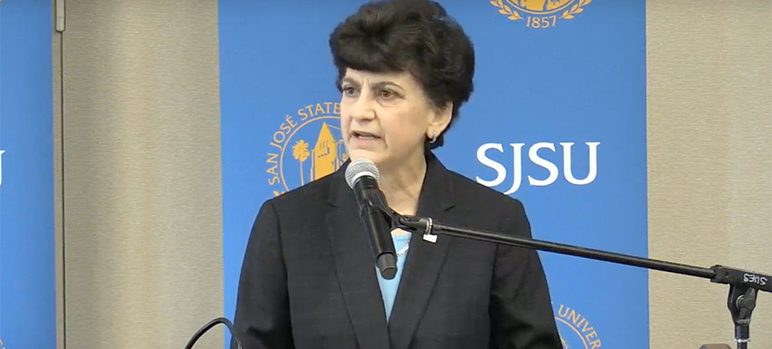With an estimated 4,000 students at San Jose State sleeping in their cars, crashing on couches or sneaking naps in the library, university leaders have unveiled a slew of initiatives to help put roofs over the heads of homeless students.
During a Monday morning presser at the Diaz Compean Student Union, SJSU President Mary Papazian announced that the university has secured $3.1 million in grants from the California State University Chancellor’s Office to tackle housing insecurity.
The largest share of the funding—$2.6 million—will be divided among the university and local non-profits for rapid re-housing. Another $400,332 will get earmarked to help pay for students’ basic needs, while the remaining $125,000 will fund mental health services.
“Comprehensive solutions require comprehensive support,” Papazian said of the plan.
The university also plans to establish a pilot program this fall that sets aside 12 or more beds for emergency housing, expands rapid re-housing and rental assistance for students and opens a dedicated SJSU Cares space in Clark Hall. The three initiatives stem from advocacy efforts by the Student Homeless Alliance (SHA)—an activist group organizers dedicated to solving the university’s homelessness crisis.
“Having our voices heard means the world to us,” SHA Vice President Briena Brown said. “This program announced today may have been created at some point in the future, but it is happening now, because of us the students.”
Members from SHA will also serve on the university’s Basic Needs Advisory Board so that “student voices guide SJSU’s next steps.” Brown said SHA aims to make the emergency bed program permanent, provide more emergency beds to students and increase the amount of money available for rapid re-housing and rental help.
State Sen. Jim Beall (D-San Jose) and Assemblyman Ash Kalra (D-San Jose) also announced this week that California will move forward with transferring an underutilized government-owned facility to the university. The Alfred E. Alquist building at 100 Paseo de San Antonio in downtown San Jose could accommodate anywhere from 800 to 1,200 housing units for faculty, students and other university staff. Last year, Beall and Kalra secured $250,000 from the state to develop a housing plan for the site.
“We have an urban campus that’s almost impossible to expand to meet the needs of the growing community,” Beall said. “But we have an opportunity with this Alquist building.”
The push to demolish the old state building to construct housing is part of a wider effort led by Beall. Last year, the veteran legislator authored SB 6, which would create a database of underutilized state-owned properties.
“I think there’s going to be an opportunity for more sites and more affordable housing projects throughout the state,” Beall explained. “I think all the universities and community colleges need affordable housing. This homeless thing with students I think [is] literally getting out of hand.”
Papazian said she hopes that students and faculty will be able to move in the new building—which will also include parking, retail and eateries—by 2025.


I’m curious who estimated that 4,000 students are sleeping in cars or the library. I’m skeptical about that assertion. The only people I see dozing in the library are grizzled transients, whom the security personnel shoo out when they find them. I live within a five-minute walk from San José State and haven’t noticed any students sleeping in cars on our block.
The number comes from a California State University Chancellor’s Office students’ basic needs study. The study examined the 2016-2017 school year and found that 13.2 percent of San Jose State students experienced homelessness in the last 12 months. That number was 2 percent higher than the CSU average.
> SJSU Announces Initiatives to Help Homeless Students
How about if SJSU announces an initiative to run a university?
Over the two days of January 29th & 30th, 2019 a point in time homeless count was done by hundreds of volunteers throughout San Jose and The County of Santa Clara California. The results of the San Jose count were a total of 6,097 homeless of which 20% were assumed to be in the college age of 18-24 years of age. That would be a total of 1,219 homeless which would be of San Jose State student age.
Today we learn that the homeless student population is 4,000 which exceeds the homeless count for this age group by 328%. So, my question is are there that many actual student homeless or is it that our count is off by over 300 percent? I don’t think you can have it both ways. https://www.sanjoseca.gov/home/showdocument?id=38890
> Over the two days of January 29th & 30th, 2019 a point in time homeless count was done by hundreds of volunteers throughout San Jose and The County of Santa Clara California.
Homeless proselytizing.
“You’re homeless, aren’t you?”
“Mmmmfffftttttt fffmmmmttt mmffffttttmmmffff.”
“You look like a college student, too.”
“Mmmmffftttmmm”.
Recent government figures show that 40% of students who enter college do not graduate, and of those who do, 70% take more than four years to graduate. Tuition keeps rising to cover the shortfall caused by those professors who teach few or no classes, yet draw salary as tenured personnel. Change “publish or perish” to “teach or perish”. Weed out the obvious non-college material at the admissions office. No-one who must take bonehead English should do so at college. They should prove their competence BEFORE they are admitted.